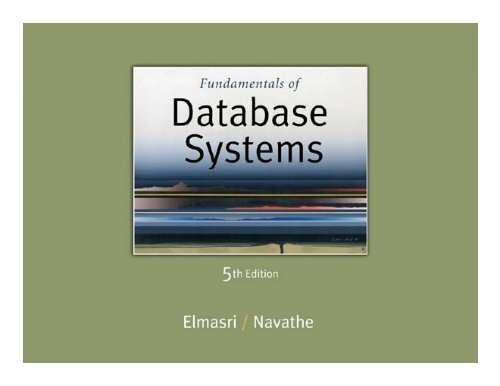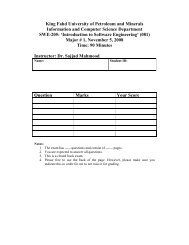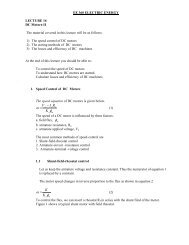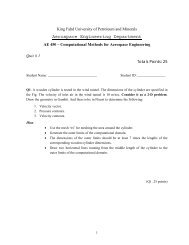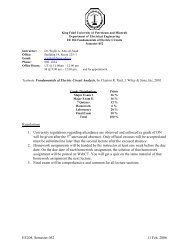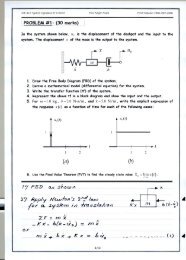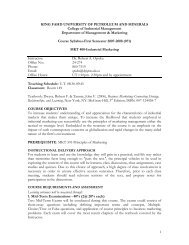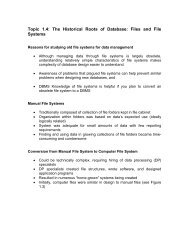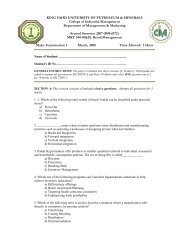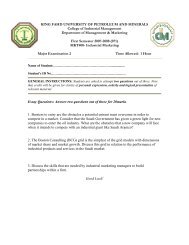Chapter10(pdf) - KFUPM Open Courseware
Chapter10(pdf) - KFUPM Open Courseware
Chapter10(pdf) - KFUPM Open Courseware
Create successful ePaper yourself
Turn your PDF publications into a flip-book with our unique Google optimized e-Paper software.
Copyright © 2007 Ramez Elmasri and Shamkant B. Navathe Slide 10- 1
Chapter 10<br />
Functional Dependencies and<br />
Normalization for Relational<br />
Databases<br />
Copyright © 2007 Ramez Elmasri and Shamkant B. Navathe
Chapter Outline<br />
• Informal Design Guidelines for Relational<br />
Databases<br />
• Functional Dependencies (FDs)<br />
• Normalization of Relations and Different Normal<br />
Forms<br />
Copyright © 2007 Ramez Elmasri and Shamkant B. Navathe Slide 10- 3
Informal Design Guidelines for Relational<br />
Databases (1)<br />
• What is relational database design<br />
• The grouping of attributes to form "good" relation<br />
schemas<br />
• Two levels of relation schemas<br />
• The logical "user view" level<br />
• The storage "base relation" level<br />
• Design is concerned mainly with base relations<br />
• What are the criteria for "good" base relations<br />
Copyright © 2007 Ramez Elmasri and Shamkant B. Navathe Slide 10- 4
Informal Design Guidelines for Relational<br />
Databases (2)<br />
• We first discuss informal guidelines for good<br />
relational design<br />
• Then we discuss formal concepts of functional<br />
dependencies and normal forms<br />
• - 1NF (First Normal Form)<br />
• - 2NF (Second Normal Form)<br />
• - 3NF (Third Normal Form)<br />
• - BCNF (Boyce-Codd Normal Form)<br />
Copyright © 2007 Ramez Elmasri and Shamkant B. Navathe Slide 10- 5
Semantics of the Relation Attributes<br />
• GUIDELINE 1: Informally, each tuple in a relation should<br />
represent one entity or relationship instance.<br />
• Attributes of different entities (EMPLOYEEs,<br />
DEPARTMENTs, PROJECTs) should not be mixed in the<br />
same relation<br />
• Only foreign keys should be used to refer to other entities<br />
• Entity and relationship attributes should be kept apart as<br />
much as possible.<br />
• Bottom Line: Design a schema that can be explained<br />
easily relation by relation. The semantics of attributes<br />
should be easy to interpret.<br />
Copyright © 2007 Ramez Elmasri and Shamkant B. Navathe Slide 10- 6
A simplified COMPANY relational<br />
database schema<br />
Copyright © 2007 Ramez Elmasri and Shamkant B. Navathe Slide 10- 7
Redundant Information in Tuples and<br />
Update Anomalies<br />
• Redundant Information causes:<br />
• storage wastage<br />
• problems with update anomalies<br />
• Insertion anomalies<br />
• Deletion anomalies<br />
• Modification anomalies<br />
Copyright © 2007 Ramez Elmasri and Shamkant B. Navathe Slide 10- 8
Two relation schemas suffering from<br />
storage wastage and update anomalies<br />
Copyright © 2007 Ramez Elmasri and Shamkant B. Navathe Slide 10- 9
Example States for EMP_DEPT and<br />
EMP_PROJPROJ<br />
Copyright © 2007 Ramez Elmasri and Shamkant B. Navathe Slide 10- 10
EXAMPLE OF AN UPDATE ANOMALY<br />
• Consider the relation:<br />
• EMP_PROJ(Emp#, Proj#, Ename, Pname,<br />
No_hours)<br />
• Update Anomaly:<br />
• Changing g the name of project number P1 from<br />
“Billing” to “Customer-Accounting” may cause this<br />
update to be made for all 100 employees working<br />
on project P1.<br />
Copyright © 2007 Ramez Elmasri and Shamkant B. Navathe Slide 10- 11
EXAMPLE OF AN INSERT ANOMALY<br />
• Consider the relation:<br />
• EMP_PROJ(Emp#, Proj#, Ename, Pname,<br />
No_hours)<br />
• Insert Anomaly:<br />
• Cannot insert a project unless an employee is<br />
assigned to it.<br />
• Conversely<br />
• Cannot insert an employee unless he/she is<br />
assigned to a project.<br />
Copyright © 2007 Ramez Elmasri and Shamkant B. Navathe Slide 10- 12
EXAMPLE OF AN DELETE ANOMALY<br />
• Consider the relation:<br />
• EMP_PROJ(Emp#, Proj#, Ename, Pname,<br />
No_hours)<br />
• Delete Anomaly:<br />
• When a project is deleted, it will result in deleting<br />
all the employees who work on that project.<br />
• Alternately, if an employee is the sole employee<br />
on a project, deleting that t employee would result in<br />
deleting the corresponding project.<br />
Copyright © 2007 Ramez Elmasri and Shamkant B. Navathe Slide 10- 13
Guideline to Redundant Information in<br />
Tuples and Update Anomalies<br />
• GUIDELINE 2:<br />
• Design a schema that does not suffer from the<br />
insertion, deletion and update anomalies.<br />
• If there are any anomalies present, then note them<br />
so that applications can be made to take them into<br />
account.<br />
Copyright © 2007 Ramez Elmasri and Shamkant B. Navathe Slide 10- 14
Null Values in Tuples<br />
• GUIDELINE 3:<br />
• Relations should be designed such that their tuples will<br />
have as few NULL values as possible<br />
• Attributes t that t are NULL frequently could be placed in<br />
separate relations (with the primary key)<br />
• Nulls are problematic in joins and aggregate g functions<br />
• Many interpretations for nulls:<br />
• Attribute not applicable or invalid<br />
• Attribute value unknown (may exist)<br />
• Value known to exist, but unavailable<br />
Copyright © 2007 Ramez Elmasri and Shamkant B. Navathe Slide 10- 15
Spurious Tuples<br />
• Bad designs for a relational database may result<br />
in erroneous results for certain JOIN operations<br />
• GUIDELINE 4:<br />
• Design relation schemas so that they can be<br />
joined with equality conditions on attributes that<br />
are (primary key, foreign key) pairs in a way that<br />
guarantees that t no spurious tuples are generated.<br />
• No spurious tuples should be generated by doing<br />
a natural-join of any relations.<br />
Copyright © 2007 Ramez Elmasri and Shamkant B. Navathe Slide 10- 16
Copyright © 2007 Ramez Elmasri and Shamkant B. Navathe Slide 10- 17
Copyright © 2007 Ramez Elmasri and Shamkant B. Navathe Slide 10- 18
Functional Dependencies (1)<br />
• Functional dependencies (FDs)<br />
• Are constraints that are derived from the meaning<br />
and interrelationships of the data attributes<br />
• Are used to specify formal measures of the<br />
"goodness" of relational designs<br />
• A set of attributes X functionally determines a set<br />
of attributes Y if the value of X determines a<br />
unique value for Y<br />
Copyright © 2007 Ramez Elmasri and Shamkant B. Navathe Slide 10- 19
Functional Dependencies (2)<br />
• X -> Y holds if whenever two tuples have the same value<br />
for X, they must thave the same value for Y<br />
• For any two tuples t1 and t2 in any relation instance r(R): If<br />
t1[X]=t2[X], then t1[Y]=t2[Y]<br />
• X -> Yi in R specifies a constraint t on all relation instances<br />
r(R)<br />
• Written as X -> Y; can be displayed graphically on a<br />
relation schema as in Figures. ( denoted d by the arrow: ).<br />
• FDs are derived from the real-world constraints on the<br />
attributes<br />
• If K is a key of R, then K functionally determines all<br />
attributes in R<br />
• since we never have two distinct tuples with t1[K]=t2[K])<br />
Copyright © 2007 Ramez Elmasri and Shamkant B. Navathe Slide 10- 20
Examples of FD constraints<br />
• Social security number determines employee<br />
name<br />
• SSN -> ENAME<br />
• Project number determines project name and<br />
location<br />
• PNUMBER -> {PNAME, PLOCATION}<br />
• Employee ssn and project number determines<br />
the hours per week that the employee works on<br />
the project<br />
• {SSN, PNUMBER} -> HOURS<br />
Copyright © 2007 Ramez Elmasri and Shamkant B. Navathe Slide 10- 21
Inference Rules for FDs<br />
• Given a set of FDs F, we can infer additional FDs that hold whenever<br />
the FDs in F hold<br />
• Armstrong's inference rules:<br />
• IR1. (Reflexive) If Y subset-of X, then X -> Y<br />
• IR2. (Augmentation) If X -> Y, then XZ -> YZ<br />
• (Notation: XZ stands for X U Z)<br />
• IR3. (Transitive) If X -> Y and Y -> Z, then X -> Z<br />
• Some additional inference rules that are useful:<br />
• Decomposition: If X -> YZ, then X -> Y and X -> Z<br />
• Union: If X -> Y and X -> Z, then X -> YZ<br />
• Psuedotransitivity: If X -> Y and WY -> Z, then WX -> Z<br />
• The last three inference rules, as well as any other inference rules,<br />
can be deduced from IR1, IR2, and IR3 (completeness property)<br />
Copyright © 2007 Ramez Elmasri and Shamkant B. Navathe Slide 10- 22
Normalization of Relations<br />
• Normalization:<br />
• The process of decomposing unsatisfactory "bad" relations by<br />
breaking up their attributes into smaller relations<br />
• Normal form:<br />
• Condition using keys and FDs of a relation to certify whether a<br />
relation schema is in a particular normal form<br />
• Normal form of a relation is the highest NF condition that it meets,<br />
and hence indicates the degree to which it has been normalized<br />
• 2NF, 3NF, BCNF<br />
• based on keys and FDs of a relation schema<br />
• 4NF<br />
• based on keys, multi-valued dependencies : MVDs<br />
• 5NF<br />
• based on keys, join dependencies d : JDs<br />
Copyright © 2007 Ramez Elmasri and Shamkant B. Navathe Slide 10- 23
Definitions of Keys and Attributes<br />
Participating in Keys (1)<br />
• A superkey of a relation schema R = {A1, A2, ....,<br />
An} is a set of attributes S subset-of R with the<br />
property that no two tuples t1 and t2 in any legal<br />
relation state r of R will have t1[S] = t2[S]<br />
• A key K is a superkey with the additional<br />
property that removal of any attribute from K will<br />
cause K not to be a superkey any more.<br />
Copyright © 2007 Ramez Elmasri and Shamkant B. Navathe Slide 10- 24
Definitions of Keys and Attributes<br />
Participating in Keys (2)<br />
• If a relation schema has more than one key, each<br />
is called a candidate key.<br />
• One of the candidate keys is arbitrarily designated<br />
to be the primary key, and the others are called<br />
secondary keys.<br />
• A Prime attribute must be a member of some<br />
candidate key<br />
• A Nonprime attribute t is not a prime attribute—<br />
t<br />
that is, it is not a member of any candidate key.<br />
Copyright © 2007 Ramez Elmasri and Shamkant B. Navathe Slide 10- 25
First Normal Form<br />
• Disallows<br />
• composite attributes<br />
• multivalued attributes<br />
• nested relations; attributes whose values for an<br />
individual tuple are non-atomic<br />
• Considered to be part of the definition of relation<br />
Copyright © 2007 Ramez Elmasri and Shamkant B. Navathe Slide 10- 26
Normalization into 1NF<br />
Copyright © 2007 Ramez Elmasri and Shamkant B. Navathe Slide 10- 27
Normalization of nested relations into 1NF<br />
Copyright © 2007 Ramez Elmasri and Shamkant B. Navathe Slide 10- 28
Second Normal Form (1)<br />
• Uses the concepts of FDs, primary key<br />
• Definitions<br />
• Prime attribute: An attribute that is member of the primary<br />
key K<br />
• Full functional dependency: a FD Y -> Z where removal<br />
of any attribute from Y means the FD does not hold any<br />
more<br />
• Examples:<br />
• {SSN, PNUMBER} -> HOURS is a full FD since neither SSN<br />
-> HOURS nor PNUMBER -> HOURS hold<br />
• {SSN, PNUMBER} -> ENAME is not a full FD (it is called a<br />
partial dependency ) since SSN -> ENAME also holds<br />
Copyright © 2007 Ramez Elmasri and Shamkant B. Navathe Slide 10- 29
Second Normal Form (2)<br />
• A relation schema R is in second normal form<br />
(2NF) if every non-prime attribute A in R is fully<br />
functionally dependent on the primary key<br />
• R can be decomposed into 2NF relations via the<br />
process of 2NF normalization<br />
Copyright © 2007 Ramez Elmasri and Shamkant B. Navathe Slide 10- 30
Normalizing into 2NF<br />
Copyright © 2007 Ramez Elmasri and Shamkant B. Navathe Slide 10- 31
Third Normal Form (1)<br />
• Definition:<br />
• Transitive functional dependency: a FD X -> Z<br />
that can be derived from two FDs X -> Y and Y -><br />
Z<br />
• Examples:<br />
• SSN -> DMGRSSN is a transitive FD<br />
• Since SSN -> DNUMBER and DNUMBER -><br />
DMGRSSN hold<br />
• SSN -> ENAME is non-transitive<br />
• Since there is no set of attributes X where SSN -> X<br />
and X -> ENAME<br />
Copyright © 2007 Ramez Elmasri and Shamkant B. Navathe Slide 10- 32
Third Normal Form (2)<br />
• A relation schema R is in third normal form (3NF) if it is<br />
in 2NF and no non-prime attribute A in R is transitively<br />
dependent on the primary key<br />
• R can be decomposed into 3NF relations via the process<br />
of 3NF normalization<br />
• NOTE:<br />
• In X -> >Y and dY -> Z, with X as the primary key, we consider<br />
this a problem only if Y is not a candidate key.<br />
• When Y is a candidate key, there is no problem with the<br />
transitive dependency d .<br />
• E.g., Consider EMP (SSN, Emp#, Salary ).<br />
• Here, SSN -> Emp# -> Salary and Emp# is a candidate key.<br />
Copyright © 2007 Ramez Elmasri and Shamkant B. Navathe Slide 10- 33
Normalizing into 3NF<br />
Copyright © 2007 Ramez Elmasri and Shamkant B. Navathe Slide 10- 34
Normal Forms Defined Informally<br />
• 1 st normal form<br />
• All attributes depend on the key<br />
• 2 nd normal form<br />
• All attributes depend on the whole key<br />
• 3 rd normal form<br />
• All attributes depend on nothing but the key<br />
Copyright © 2007 Ramez Elmasri and Shamkant B. Navathe Slide 10- 35
General Normal Form Definitions (1)<br />
• The above definitions consider the primary key<br />
only<br />
• The following more general definitions take into<br />
account relations with multiple candidate keys<br />
• A relation schema R is in second normal form<br />
(2NF) if every non-prime attribute A in R is fully<br />
functionally dependent on every key of R<br />
Copyright © 2007 Ramez Elmasri and Shamkant B. Navathe Slide 10- 36
General Normal Form Definitions (2)<br />
• Definition:<br />
• Superkey of relation schema R - a set of attributes<br />
S of R that contains a key of R<br />
• A relation schema R is in third normal form (3NF)<br />
if whenever a FD X -> A holds in R, then either:<br />
• (a) X is a superkey of R, or<br />
• (b) A is a prime attribute of R<br />
• NOTE: Boyce-Codd normal form disallows<br />
condition (b) above<br />
Copyright © 2007 Ramez Elmasri and Shamkant B. Navathe Slide 10- 37
Normalization into General 2NF and 3NF<br />
Copyright © 2007 Ramez Elmasri and Shamkant B. Navathe Slide 10- 38
BCNF (Boyce-Codd Normal Form)<br />
• A relation schema R is in Boyce-Codd Normal Form<br />
(BCNF) if whenever an FD X -> A holds in R, then X is a<br />
superkey of R<br />
• Each normal form is strictly tl stronger than the previous<br />
one<br />
• Every 2NF relation is in 1NF<br />
• Every 3NF relation is in 2NF<br />
• Every BCNF relation is in 3NF<br />
• There exist relations that are in 3NF but not in BCNF<br />
• The goal is to have each relation in BCNF (or 3NF)<br />
Copyright © 2007 Ramez Elmasri and Shamkant B. Navathe Slide 10- 39
Boyce-Codd normal form<br />
Copyright © 2007 Ramez Elmasri and Shamkant B. Navathe Slide 10- 40
A relation TEACH that is in 3NF but not in<br />
BCNF<br />
fd1: { student, course} -> instructor<br />
fd2: instructor -> course<br />
Copyright © 2007 Ramez Elmasri and Shamkant B. Navathe Slide 10- 41
Achieving the BCNF by Decomposition<br />
• Two FDs exist in the relation TEACH:<br />
• fd1: { student, course} -> instructor<br />
• fd2: instructor -> course<br />
• {student, course} is a candidate key for this<br />
relation and that the dependencies shown follow<br />
the pattern in Figure 10.1212 (b).<br />
• So this relation is in 3NF but not in BCNF<br />
• A relation NOT in BCNF should be decomposed<br />
so as to meet this property.<br />
• {instructor, course } and {instructor, student}<br />
Copyright © 2007 Ramez Elmasri and Shamkant B. Navathe Slide 10- 42


